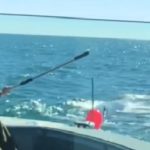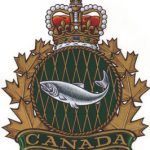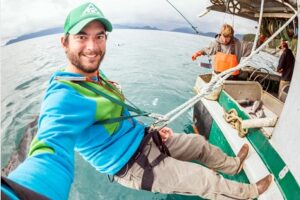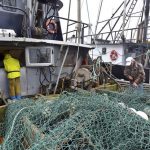Tag Archives: invasive species
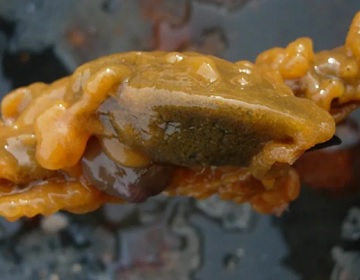
Sea vomit: Why DFO is worried about an invasive species with a disgusting name
Fisheries and Oceans Canada is asking fishermen to keep an eye out for an invasive species in the Bay of Fundy, one that has an unforgettable nickname. Pancake batter tunicate, more commonly known by its colloquial name sea vomit, has been spotted on the east coast of North America since 1982. The species is a creamy white colour, is slimy to the touch and is native to the ocean around Japan. It’s only been confirmed north of the U.S. border since 2013, but there is some evidence the invasive species is growing more prevalent in New Brunswick waters. >click to read< 09:06
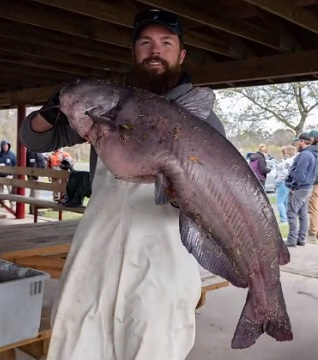
This invasive fish population is exploding as native Blue Crab populations hit record lows.
The invasive species in question is the blue catfish, a species so large it has become known as the “River Monster of the Potomac ” and other major Chesapeake Bay tributaries. The catfish’s diet includes native Blue Crabs. A November 2021 study from the Virginia Institute of Marine Science reports the catfish consumed as many as 2.3 million crabs per year from a study area in the lower James River. The first blue catfish were intentionally imported into the James River in Virginia during the 1980s. The species is native to the Mississippi valley. The fish are huge and consume almost any other species of wildlife they can encounter, catch and swallow, including crabs and other shellfish, Love said. Researchers have found the blue catfish will even eat ducks. >click to read< 07:59
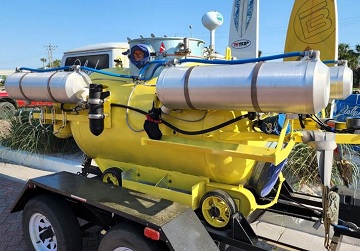
Sea Hunt! Sub proposed for war on lionfish
Two marine enthusiasts are taking lionfish hunting to a whole new level, and depth as they are working on outfitting a submarine to wage war on one of Florida’s most-wanted invasive species. Scott Gonnello and Scott Cassell have begun plans to outfit a one-person Kittredge K-250 submarine into an underwater lionfish hunting machine and plan to bring the sub to John Pennekamp Coral Reef State Park in Key Largo for World Oceans Day on Wednesday, June 8. The sub was first welded together in the 1970s but was rotting away in a backyard in Cassell’s home state of California until he obtained it 1991. Cassell has since logged more than 15,000 hours under sea in it, he said. >click to read< 10:33

Nature is not a Whore!!!
We have incredible fishing grounds on our East Coast!!! Why destroy a renewable sustainable Resource??? Molesting these grounds by dumping massive amounts of construction materials on them is insane!!! Keep in mind the many rules the EPA has against ocean dumping!!! Not to mention the likely hood of them turning into a Dumping Ground after they become useless… Out of sight out of mind!!! What wonderful habitat the Turbine bases will make for the Green Crabs ocean Locust!!! We can’t forget about the Whales… The European Wind Farms do not see a significant Whale migration… What aren’t they saying??? >click to read< 09:41
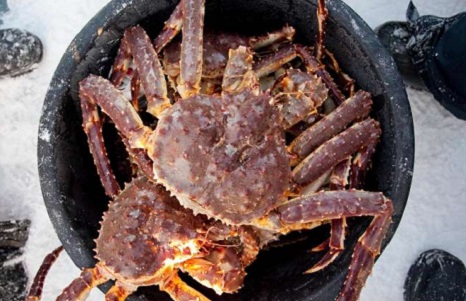
Crab-22: how Norway’s fisheries got rich on an invasive species
The Norwegian fishing village of Bugøynes, 310 miles north of the Arctic Circle and a frigid, dark place for much of the year, was on the edge of ruin. Work was scarce. Years of overfishing and mismanagement had stymied cod quotas. Boats lay idle in cold waters. Those who chose to stay were forced to rely on what meagre wages they could still muster from fishing and processing. That is, until the crabs arrived.,, Unknown to the fishermen, the crustaceans had traveled from Russia, where scientists had introduced red king crabs on the Murman coast during the 1960s with the goal of establishing a new, lucrative fishery. Slowly, the crabs scuttled the 60 or so miles over the border,,, >click to read< 07:39
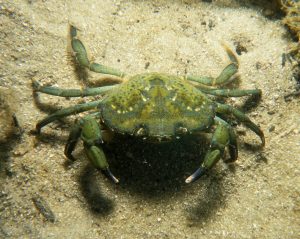
Transported in ship ballast, Invasive crab poses threat to coastal ecosystem
Alaska normally welcomes European tourists. One traveler who’s been officially banned, however, is the European green crab, an invasive species with the potential to overrun coastal ecosystems. The green crab has already colonized Washington and parts of British Columbia, and conservationists want to delay its arrival in Alaska for as long as possible. The green crab lacks predators outside its original habitat,,, >click to read< 20:35

Asian Carp Crisis: Sen. Blackburn meets with fishermen in Henry County
Local fishermen and government agencies met at North American Caviar Inc. in Henry County Friday morning to discuss solutions to a looming crisis. “Before the carp, no, I’ve never seen anything like this,” said local commercial fisherman Neil Matlock. For small businesses like North American Caviar, harvesting carp isn’t as lucrative. Local fishermen agreed that they need more help from the state if they want to expand capacity and catch more carp. >click to read< 09:45
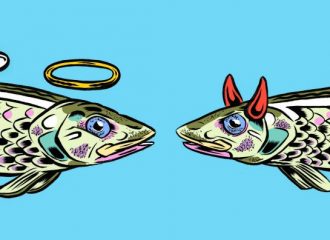
What Happens When Humans Fall In Love With An Invasive Species
Some people miss the glory days of Lester River fishing even when evidence suggests that Lake Superior and the people who rely on it are better off now. Facts, it turns out, can’t always sway emotion or reshape business plans. And these issues are not unique to smelt. All over the world, you’ll find invasive species that are beloved by humans — even as these foreign plants and animals alter or damage the environment. The fight against invasive species is often framed as a technological problem — how do you selectively eliminate a species once it’s made itself at home in an environment? But in reality, it’s also a question of human hearts and minds. And those might be the harder obstacle to clear. >click to read<19:00
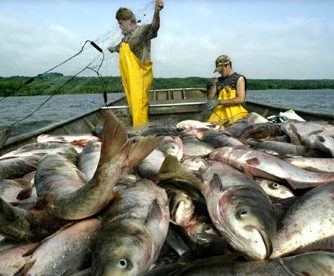
Canadian fishermen want cheaper lobster bait. Americans want to stop an invasive fish. And so, one man hatches a plan
Like whales breaching ocean swells, silver carp fly out from beneath the surface of waterways in Illinois. Tens of millions of dollars have been spent trying to keep the invasive fish – which procreate rapidly, crowding out other marine life – from spilling into the $7-billion Great Lakes fishery. And in an era of expeditious information-sharing, the “flying fish,” a form of Asian carp imported into the States decades ago, with hopes of using them to manage American ecosystems, have also caught the attention of gawking social-media spectators around the world. Three years ago, one of those spectators was a Nova Scotian named Patrick J. Swim. But instead of merely gawking, the self-described “lobsterpreneur” hatched a plan: >click to read<12:32
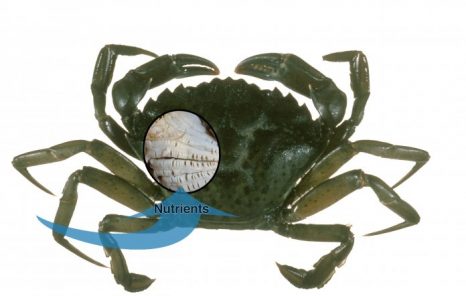
A green crab’s super power: eating through its gills
The phrase “to inhale your food” evokes images of hot dog eating contests or late night fast food binges. But for the European green crab, the phrase is a bit more literal—these crabs can actually absorb food through their gills.,,, Called the shore crab in its native waters around Europe, the European green crab is an invasive species that began wreaking havoc in New England coastal ecosystems following its introduction in the 1800s. It has no predators or competitors and also a killer appetite—crab, fish, young lobster, and shellfish are no match for its nimble, yet crushing claws. >click here to read< 11:27 
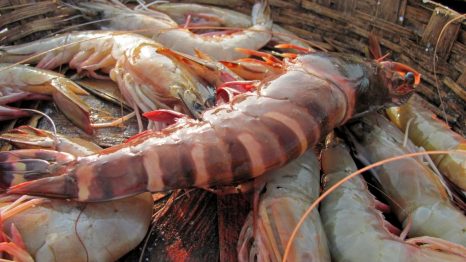
Invasive Shrimp Grows to More Than a Pound in TX Waters
Did you know there are shrimp in Texas that can grow to weigh more than a pound? The black tiger prawn (Penaeus monodon) or tiger shrimp is an aggressive mollusk that can grow to a foot in length and weigh a pound according to Texas Invasive Species Institute. “In addition to it’s unusually large size, it can be identified by black stripes across the dorsal side of the tail. It can also be black in body color with orange stripes on it’s back, resembling a tiger.” >click here to read< 13:06
Buddhists fined almost £30,000 – for releasing foreign lobsters bought in Greenwich into the sea.
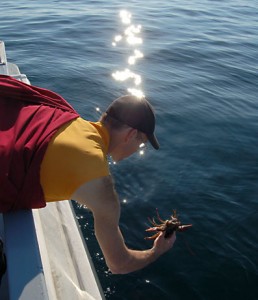 Ni Li and Zhixiong Li were among 100 Buddhists who released the crustaceans into the Channel as part of a religious ceremony – despite them being an invasive species. They spent more than £5,500 on 361 live American lobsters and 35 Dungeness crabs, which they released from three boats, chartered off Brighton Marina.,,, But the ceremony on June 15, 2015 wreaked havoc on local marine life, forcing the Marine Management Organisation (MMO) to offer local fishermen £20 for each alien lobster they caught. click here to read the story 11:48
Ni Li and Zhixiong Li were among 100 Buddhists who released the crustaceans into the Channel as part of a religious ceremony – despite them being an invasive species. They spent more than £5,500 on 361 live American lobsters and 35 Dungeness crabs, which they released from three boats, chartered off Brighton Marina.,,, But the ceremony on June 15, 2015 wreaked havoc on local marine life, forcing the Marine Management Organisation (MMO) to offer local fishermen £20 for each alien lobster they caught. click here to read the story 11:48
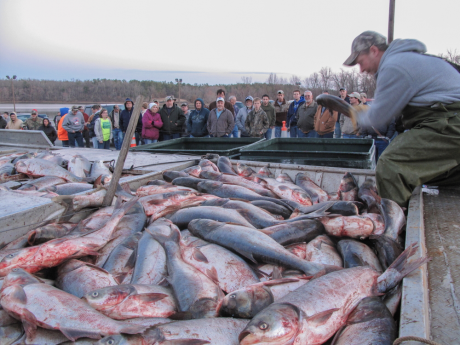
Kentucky State Fish and Wildlife Department seeking input on entrepreneurial solutions for Asian carp problem
Asian carp swim by the millions in Kentucky’s waterways, threatening to crowd out native fish in some of the state’s most cherished fishing destinations – including Kentucky and Barkley lakes in the west. With an absence of predators and little natural controls available for these invasive species, the Kentucky Department of Fish and Wildlife Resources, the state Tourism, Arts and Heritage Cabinet and the Commonwealth of Kentucky are seeking public input on a plan to limit the explosive growth of Asian carp populations while providing a valuable protein source for people. State officials will evaluate a potential public/private partnership to boost the emerging Asian carp fish processing business in Kentucky. State support of entrepreneurs could include hiring commercial anglers and rental of necessary equipment; supplying freezer space in warehouses; purchasing catches during low demand times; and cash incentives, among other potential solutions. click here to read the story 08:30
Telling it like it is! NOAA has done enough already and has failed in spectacular fashion
 One wonders why a Marine Sanctuary is needed to protect shipwrecks. Sanctuaries are usually established to protect ecosystems. The typical reason for establishing a Sanctuary off our shores is inapplicable because our native ecosystem has been destroyed. After the opening of the Saint Lawrence Seaway in 1959 NOAA was assigned the responsibility of protecting the Great Lakes from invasive species, essentially making the entire region a sanctuary. NOAA has failed in spectacular fashion.,, NOAA allowed the Lamprey Eel and Alewife into our native waters shortly after the Seaway opened. These and other foreigners decimated our native fishery. Smelt survived until the 1980’s but now they too have been displaced by some other invasive species that NOAA failed to protect us from, was it the Quagga Mussel or the Round Gobi? (must read) Click here to read the letter. 10:04
One wonders why a Marine Sanctuary is needed to protect shipwrecks. Sanctuaries are usually established to protect ecosystems. The typical reason for establishing a Sanctuary off our shores is inapplicable because our native ecosystem has been destroyed. After the opening of the Saint Lawrence Seaway in 1959 NOAA was assigned the responsibility of protecting the Great Lakes from invasive species, essentially making the entire region a sanctuary. NOAA has failed in spectacular fashion.,, NOAA allowed the Lamprey Eel and Alewife into our native waters shortly after the Seaway opened. These and other foreigners decimated our native fishery. Smelt survived until the 1980’s but now they too have been displaced by some other invasive species that NOAA failed to protect us from, was it the Quagga Mussel or the Round Gobi? (must read) Click here to read the letter. 10:04

REWARD!! Michigan DNR Offers Big Reward For Plan To Block Invasive Fish
If the fishing world had a most-wanted list, Asian carp surely top it. There are plenty of despised invasives plaguing U.S. waters, but how many of them have a $1 million dollar bounty on their heads? That’s what the Michigan Department of Natural Resources just dropped on the table. Show the agency a viable plan for stopping those silver and big head carp from reaching the Great Lakes and you could be eligible for a sweet payday. In case you haven’t already heard the tale, Asian carp are prolific breeders that can reach 50-pounds. The filter-feeding invasives consume massive amounts of the tiny plants (phytoplankton) and animals (zooplankton) that feed native forage species, along with juvenile sport fish such as walleye and yellow perch. Disrupting the food web can wreak havoc on local fisheries. Read the story here with link to DNR 12:21
Invader green crabs from Europe threaten havoc in Puget Sound
 Emily Grason and Sean McDonald trudge through the mud of San Juan Island’s Westcott Bay on the hunt for something they hope not to find: A 3-inch menace: the European green crab. In late August, a single adult male was found for the first time in Washington’s inland sea. University of Washington researchers responded, arriving at the location of that first sighting with hundreds of traps in tow. “It might seem like it’s crazy for us to have such an intense trapping effort for just a single crab being found. One crab, what’s the big deal?” says Emily Grason, project coordinator for the Washington Sea Grant Crab Team. “But these crabs do tend to show up in numbers and where there’s one, there’s often more.” Video, read the story here 17:24
Emily Grason and Sean McDonald trudge through the mud of San Juan Island’s Westcott Bay on the hunt for something they hope not to find: A 3-inch menace: the European green crab. In late August, a single adult male was found for the first time in Washington’s inland sea. University of Washington researchers responded, arriving at the location of that first sighting with hundreds of traps in tow. “It might seem like it’s crazy for us to have such an intense trapping effort for just a single crab being found. One crab, what’s the big deal?” says Emily Grason, project coordinator for the Washington Sea Grant Crab Team. “But these crabs do tend to show up in numbers and where there’s one, there’s often more.” Video, read the story here 17:24
EU approves Sweden’s American lobster assessment
 The Swedish risk assessment of American lobster is now approved by the EU, furthering the process that could lead to American lobster being added to the list of invasive species. ‘It is of course positive that our risk assessment meets the requirements of the EU regulation,’ said Sofia Brockmark of the Swedish Agency for Maritime and Water Management (HaV). The regulation aims to prevent, minimise and mitigate the impacts of invasive alien species of animals and nature, human health or the economy. It requires Member States, inter alia, to identify how the species spread and to ensure that the spread is stopped or limited. The species on the list are also subject to various restrictions, including the ban on the import, breeding or keeping alive. Now that the risk assessment has been approved by the EU’s scientific forum for invasive alien species, it can be put forward to the EU’s executive committee. Read the story here 09:03
The Swedish risk assessment of American lobster is now approved by the EU, furthering the process that could lead to American lobster being added to the list of invasive species. ‘It is of course positive that our risk assessment meets the requirements of the EU regulation,’ said Sofia Brockmark of the Swedish Agency for Maritime and Water Management (HaV). The regulation aims to prevent, minimise and mitigate the impacts of invasive alien species of animals and nature, human health or the economy. It requires Member States, inter alia, to identify how the species spread and to ensure that the spread is stopped or limited. The species on the list are also subject to various restrictions, including the ban on the import, breeding or keeping alive. Now that the risk assessment has been approved by the EU’s scientific forum for invasive alien species, it can be put forward to the EU’s executive committee. Read the story here 09:03
EU moves one step closer to banning North American lobsters
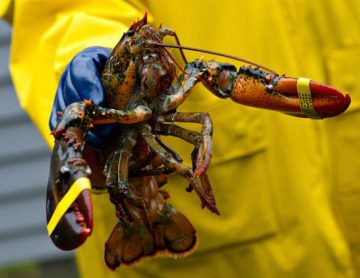 The European Union has moved one step closer to a possible ban on live North American lobsters after its scientific advisory forum released a recommendation in favour of including the animal on its invasive species list. In a decision released Tuesday morning, the EU scientific forum said it has submitted a “positive opinion” on the validity of an earlier proposal from Sweden to ban lobsters from Canada and the United States. A final decision by the EU is expected in April of 2017. In December, 2015, Sweden proposed a ban on live North American lobsters in the EU. In its proposal, Sweden argued that North American lobsters have been found in European waters in the past, and that the species could threaten local species. Read the rest of the story here 10:23
The European Union has moved one step closer to a possible ban on live North American lobsters after its scientific advisory forum released a recommendation in favour of including the animal on its invasive species list. In a decision released Tuesday morning, the EU scientific forum said it has submitted a “positive opinion” on the validity of an earlier proposal from Sweden to ban lobsters from Canada and the United States. A final decision by the EU is expected in April of 2017. In December, 2015, Sweden proposed a ban on live North American lobsters in the EU. In its proposal, Sweden argued that North American lobsters have been found in European waters in the past, and that the species could threaten local species. Read the rest of the story here 10:23
Why Green Crabs Are Invading the East Coast
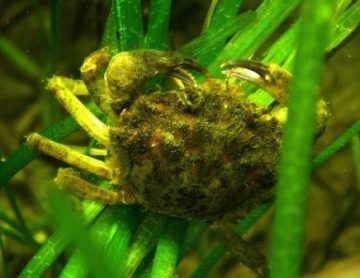 In the Gulf of Maine, as elsewhere in the world, many species are feeling the pressure brought on by climate change. A changing environment makes them more susceptible to one existential threat: invasive species. This, in turn, is having a huge impact on the local fishing industry that employs tens of thousands of people in the area, and provides seafood to the local restaurants that Maine is famous for. In short, the health of the Maine economy largely depends on the health of the Gulf of Maine, and the marine species that have made it their home. But invasive species like green crabs are coming in and wreaking havoc. Foreign species are defined as invasive when they cause the displacement of an endemic one. In the Gulf of Maine, that includes eelgrass, blue mussels, oysters, and many other types of shellfish. Invaders disrupt the trophic hierarchy,, Read the story here 15:35
In the Gulf of Maine, as elsewhere in the world, many species are feeling the pressure brought on by climate change. A changing environment makes them more susceptible to one existential threat: invasive species. This, in turn, is having a huge impact on the local fishing industry that employs tens of thousands of people in the area, and provides seafood to the local restaurants that Maine is famous for. In short, the health of the Maine economy largely depends on the health of the Gulf of Maine, and the marine species that have made it their home. But invasive species like green crabs are coming in and wreaking havoc. Foreign species are defined as invasive when they cause the displacement of an endemic one. In the Gulf of Maine, that includes eelgrass, blue mussels, oysters, and many other types of shellfish. Invaders disrupt the trophic hierarchy,, Read the story here 15:35
The seemingly ‘unstoppable’ lionfish flooding Florida’s coast and beyond
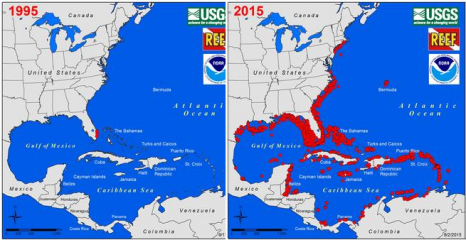 In 2011, when Rachel Bowman saw an abundance of large, pretty reddish fish while riding in a boat across the Florida coast, she didn’t think much of it. But a year later, once she got certified to dive, she speared the exotic fish and recognized an opportunity. Three years later, the fisherwoman, who was born in North Carolina and whose father was a shrimper, is selling this creature, called lionfish, to restaurants, local markets and 26 Whole Foods Markets across Florida. “I’m the first person to sell [lionfish] to Whole Foods and to set up that deal,” Bowman told CNBC. And in the Sunshine State, many other commercial fishing operations have begun to sell lionfish as well. The fish’s reproductive habits may bolster their successful invasion. Females may be able to spawn as often as every four days, which could result in the release of up to 2 million eggs a year from a single fish, according to USGS. Read the story here 08:05
In 2011, when Rachel Bowman saw an abundance of large, pretty reddish fish while riding in a boat across the Florida coast, she didn’t think much of it. But a year later, once she got certified to dive, she speared the exotic fish and recognized an opportunity. Three years later, the fisherwoman, who was born in North Carolina and whose father was a shrimper, is selling this creature, called lionfish, to restaurants, local markets and 26 Whole Foods Markets across Florida. “I’m the first person to sell [lionfish] to Whole Foods and to set up that deal,” Bowman told CNBC. And in the Sunshine State, many other commercial fishing operations have begun to sell lionfish as well. The fish’s reproductive habits may bolster their successful invasion. Females may be able to spawn as often as every four days, which could result in the release of up to 2 million eggs a year from a single fish, according to USGS. Read the story here 08:05
What a surprise! Fishermen can catch grass carp, but government scientists can’t!
 Despite Quebec’s investment of $1.7 million to tackle a possible grass carp invasion, scientists have yet to locate any specimens themselves. Quebec’s Forests, Wildlife and Parks Ministry was quick to roll out a plan to combat the invasive species after two fishermen in the Lanaudière region caught a 29-kilogram grass carp in the St. Lawrence River May 27. Government scientists’ subsequent fishing expeditions have taken place in the Contrecœur area, about 60 kilometres northeast of Montreal. Tuesday, the ministry announced they have come up empty-handed. At this stage, laboratory tests are underway to determine the presence of grass carp DNA in the St. Lawrence River, sampling water from different areas. Those results will be available at the beginning of July. The grass carp is a type of Asian carp. The one that was caught in the St. Lawrence River was estimated to be between 15 and 30 years old. link 10:17
Despite Quebec’s investment of $1.7 million to tackle a possible grass carp invasion, scientists have yet to locate any specimens themselves. Quebec’s Forests, Wildlife and Parks Ministry was quick to roll out a plan to combat the invasive species after two fishermen in the Lanaudière region caught a 29-kilogram grass carp in the St. Lawrence River May 27. Government scientists’ subsequent fishing expeditions have taken place in the Contrecœur area, about 60 kilometres northeast of Montreal. Tuesday, the ministry announced they have come up empty-handed. At this stage, laboratory tests are underway to determine the presence of grass carp DNA in the St. Lawrence River, sampling water from different areas. Those results will be available at the beginning of July. The grass carp is a type of Asian carp. The one that was caught in the St. Lawrence River was estimated to be between 15 and 30 years old. link 10:17
Maine lobster suppliers joined Massachusetts and Canadian peers in Brussels to foil EU import ban
 The six Maine companies joined their Massachusetts and Canadian peers, as well as national trade officials, to discuss the proposed ban with buyers and trade officials from eight European countries, including the three biggest importers of Homarus americanus: France, Italy and Spain. The meeting occurred at the world’s largest seafood industry trade show, said spokesman Gavin Gibbons of the National Fisheries Institute, an American seafood industry trade group. About 75 people met for 90 minutes to talk about how to avoid the all-out ban that Sweden asked the European Union to adopt in March after finding North American lobsters in European waters. Read the story here 13:19
The six Maine companies joined their Massachusetts and Canadian peers, as well as national trade officials, to discuss the proposed ban with buyers and trade officials from eight European countries, including the three biggest importers of Homarus americanus: France, Italy and Spain. The meeting occurred at the world’s largest seafood industry trade show, said spokesman Gavin Gibbons of the National Fisheries Institute, an American seafood industry trade group. About 75 people met for 90 minutes to talk about how to avoid the all-out ban that Sweden asked the European Union to adopt in March after finding North American lobsters in European waters. Read the story here 13:19
Fishermen encouraged to take big bite out of Bay’s blue catfish population
 For years, Rocky Rice made his living primarily by fishing two of the Bay’s most iconic species: striped bass in the spring and blue crabs much of the summer. But after several years of poor blue crab catches, and with new catch limits on striped bass being put in place, Rice added one of the Bay’s most troublesome species to his mix: blue catfish. Rice is one of a growing number of fishermen responding to the plea of fishery officials to catch as many of the voracious predators as they can. Read the rest here 17:07
For years, Rocky Rice made his living primarily by fishing two of the Bay’s most iconic species: striped bass in the spring and blue crabs much of the summer. But after several years of poor blue crab catches, and with new catch limits on striped bass being put in place, Rice added one of the Bay’s most troublesome species to his mix: blue catfish. Rice is one of a growing number of fishermen responding to the plea of fishery officials to catch as many of the voracious predators as they can. Read the rest here 17:07
Invasive Impact: What’s the Status of Invasive Species in Alaska?
 Fisheries are an economic and employment engine in Alaska, with the commercial and recreational sectors generating $4.8 billion in sales impacts and 61,000 jobs in 2012. However, invasive species, or species that are introduced to a new area where they have the potential to cause harm, could significantly affect the ecosystems that make Alaska so productive for fisheries. Read the rest here 08:24
Fisheries are an economic and employment engine in Alaska, with the commercial and recreational sectors generating $4.8 billion in sales impacts and 61,000 jobs in 2012. However, invasive species, or species that are introduced to a new area where they have the potential to cause harm, could significantly affect the ecosystems that make Alaska so productive for fisheries. Read the rest here 08:24
DFO find’s non native shrimp along the shores of Newfoundland’s west coast.
 For the second time this year, DFO scientists have discovered a new species in the province’s coastal waters. Baltic shrimp have now found a permanent home in Newfoundland. Specimens have been identified from the Magdalen Islands to York Harbour. “Despite regulation, ballast water controls and for transportation and that kind of stuff coming from other countries, things are slipping through the cracks,” he said. In December, DFO scientists discovered a new species of razor clam based on samples collected,,, Read the rest here 07:33
For the second time this year, DFO scientists have discovered a new species in the province’s coastal waters. Baltic shrimp have now found a permanent home in Newfoundland. Specimens have been identified from the Magdalen Islands to York Harbour. “Despite regulation, ballast water controls and for transportation and that kind of stuff coming from other countries, things are slipping through the cracks,” he said. In December, DFO scientists discovered a new species of razor clam based on samples collected,,, Read the rest here 07:33
Lionfish Causing Problems for the Panhandle
 The FWC has been bringing awareness to some of Florida’s most invasive species with Invasive Species Awareness Week. One particular highlighted menace has been creeping into the Gulf since 1985. The lionfish is causing problems for some of Florida’s native species which is in turn causing problems for both recreational and commercial fishing, especially here in the Panhandle. Video, Read the rest here 09:42
The FWC has been bringing awareness to some of Florida’s most invasive species with Invasive Species Awareness Week. One particular highlighted menace has been creeping into the Gulf since 1985. The lionfish is causing problems for some of Florida’s native species which is in turn causing problems for both recreational and commercial fishing, especially here in the Panhandle. Video, Read the rest here 09:42
One Great Lakes invasive species may have found a niche
 Can invasive species be good news – rather than bad – for native fish in the Great Lakes? That sounds counterintuitive, but a new study shows that the invasive round goby has become an important food source for several native species, especially smallmouth bass, but with benefits also for yellow perch and walleye. The study calls the round goby “one of the most successful aquatic invaders” in the Great Lakes. Read the rest here 18:03
Can invasive species be good news – rather than bad – for native fish in the Great Lakes? That sounds counterintuitive, but a new study shows that the invasive round goby has become an important food source for several native species, especially smallmouth bass, but with benefits also for yellow perch and walleye. The study calls the round goby “one of the most successful aquatic invaders” in the Great Lakes. Read the rest here 18:03
Lake Manitoba Commercial Fishing In Jeopardy
The local commercial fishing industry is being threatened by the  into Lake Manitoba. Fishermen have noticed more jackfish, also known as northern pike, since water from the Assiniboine River was diverted into Lake Manitoba during the flood of 2011. Perry Gaudry’s a commercial ice fisherman, and says the increased population is starting to reduce the population of the other fish. Read the rest here 12:27
into Lake Manitoba. Fishermen have noticed more jackfish, also known as northern pike, since water from the Assiniboine River was diverted into Lake Manitoba during the flood of 2011. Perry Gaudry’s a commercial ice fisherman, and says the increased population is starting to reduce the population of the other fish. Read the rest here 12:27
Great Lakes fishery managers need insight on climate change impacts
 Great Lakes fishery managers worry that their operations may be harmed by invasive species, habitat loss in the long run, according to a new study. Read the rest here 08:52
Great Lakes fishery managers worry that their operations may be harmed by invasive species, habitat loss in the long run, according to a new study. Read the rest here 08:52



































